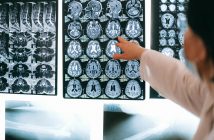I was 7 years old the first time I became aware of the message that gaining weight was undesirable. I was in a department store fitting room with my mom. Upon the realization that she had gone up in size, my usually even-keeled mother began to cry right there in the dressing room. I attempted to console her, and though she quickly collected herself, the message had already been imprinted on my mind: It wasn’t OK to gain weight.
Growing up, I watched my mom exercise and diet almost obsessively on and off throughout her busy schedule as a full-time home health nurse and a single mom. As I entered adolescence, I grew fearful of gaining weight; despite my naturally small frame, I would think negatively of myself with even the slightest weight gain.
This experience is commonplace in a generation flooded with images of super-thin celebrities and fed daily messages to be perfect by all means necessary. The growing number of eating disorders abroad and in China echoes this reality. I spoke with two Beijing-based counselors and logged on to a “pro-ana” (short for “pro-anorexia”) website to learn more about eating disorders, as well as the role of media and society in shaping our perceptions of body image.
Distorted Images
“Eating disorders are particularly difficult to treat and are the most lethal of all mental health disorders,” says Eleanor Wong of Oasis International Hospital’s Family Counseling Center. Wong is a marriage and family counselor with experience treating women with eating disorders.
Eating disorders are prevalent in China and the number is growing, says Dr. Wong. “According to the Shanghai Mental Health Bureau, the number of patients has increased three- to five-fold over the last ten years and is still increasing yearly,” she says.
We also spoke to Clinical Counselor Rachel Heffield, who specializes in women’s issues. At the time of the interview, she worked at Agape Counseling and Training Center but is now employed at International SOS Beijing Clinic. She says: “Eating disorders have filled about 20 percent of my client load over the past four years. All of these disorders are most common among young women and they usually appear as their bodies and self-concepts are changing.”
Anorexia nervosa and bulimia nervosa are the two main types of eating disorders, though a new disease was recently added in the latest edition of the Diagnostic and Statistical Manual of Mental Disorders: binge eating disorder.
Binge eating disorder (BED) is characterized by compulsive overeating in which people consume huge amounts of food while feeling out of control and powerless to stop. Recognized as the most prevalent eating disorder in the US, up to 40 percent of binge eaters are actually male. Like anorexia and bulimia, BED has a strong emotional component. Experts connect male binge eating with low self-esteem, especially relating to physical competitiveness and sexual attractiveness. BED has a genetic component and is often seen among obese patients.
Individuals struggling with bulimia, on the other hand, have an intense fear of gaining weight and use drastic methods such as induced vomiting, misuse of laxatives and diuretics, and/or excessive exercise to prevent weight gain.
“Symptoms are accompanied by recurrent episodes of binging and compensatory behaviors such as purging, fasting, or extreme exercise,” says Heffield. “Bulimia and binge eating are also not necessarily accompanied by lower-than-average weight.”
Conversely, individuals with anorexia nervosa have low body weight, an intense fear of gaining weight, and a distorted body image. “The diagnostic features for anorexia are refusal to eat and maintaining a weight that is at least 15 percent less than the normal weight for their age and height. Eating and weight control become an obsession,” says Wong.
Anorexia is the third most common chronic illness among adolescents, according to the National Association of Anorexia Nervosa and Associated Disorders (ANAD). However, identifying someone with an eating disorder is becoming more and more challenging. “Many young people nowadays have dieting habits, so people usually hide their disorder for a long time,” explains Wong.
Eating disorders are seen as only affecting teenage girls, but boys are also at risk. For teenage boys, body obsession is commonly tied to athletic performance, particularly in wrestling, boxing, or rowing, where regular weigh-ins are required. It’s not uncommon for boys to practice unhealthy habits such as compulsive exercise, fasting, and even using steroids in order to lower body fat, build muscle, or stay competitive. Fixation can lead to negative self-image and eating disorders.
Pro-Ana, Pro-Mia, and Thinspiration
To better understand the mentality of someone with an eating disorder, I created an account on a pro-ana website (proanaonline.com). The pro-ana movement idolizes anorexia and thin bodies. Different groups have different stances; many claim they do not promote eating disorders but exist simply as a non-judgmental environment and support system. Other pro-ana sites argue that anorexia is a lifestyle choice and should be respected by doctors and family. “Pro-mia” means pro-bulimia and is often used interchangeably with pro-ana. Followers sometimes wear red bracelets as a way to discreetly identify themselves to other community members while pro-mia followers wear blue or purple bracelets.
Before I was able to log into my account, I was asked to create a username, password, and identify my eating disorder. Once signup was complete, the login page displayed a warning: “This site may be triggering to those in recovery, or thinking about recovery. This is a Pro ED (eating disorder) site for those not in recovery. Please use caution when entering. If you think you might be triggered, leave now.”
I was taken to the homepage, where I saw photos promoting “thinspiration.” The latter refers to images or videos of slim women meant to “inspire” members to be thin and motivate each other. Thinspiration can also take the form of lyrics, poems, or quotes; one well-known thinspiration mantra was coined by former English supermodel Kate Moss in an interview she gave in 2009: “Nothing tastes as good as skinny feels.”
On the website, users usually had a thinspiration saying attached to their name. “The only number that will ever be enough is zero,” said one signature. “Tried to save myself but myself keeps slipping away,” said another.
Daily topics are shared in threads, and users post images of themselves and various body parts that other members are free to comment on. One thread was titled, “Went on a body checking spree.” The user went on to post images of her extremely thin arms, legs, and stomach as well as more close-up shots of her spine and pelvis, describing these parts as ‘the bones with which I am the most obsessed.’ Responses to the photos were overwhelmingly positive. “I hope you’re doing OK darling, you’re tiny, please be safe,” commented one person.
Photos of emaciated women dominated the website, but I found that users generally didn’t glamorize their eating disorders. Instead, they shared individual stories of their decent into anorexia and acknowledged that an eating disorder is, in fact, an illness. “An eating disorder is called a disorder for a reason,” said one male user.
The Catwalk’s Role
Undoubtedly, the media influences and often sets standards of beauty and body image. “There are numerous factors that influence eating disorders: family problems, school and peer pressures, having low self-esteem, struggling with loneliness, depression and anxiety, but the first on the list is the media,” says Wong.
“For women, there’s a pressure to meet societal standards of beauty,” adds Heffield. “The media and entertainment industry can be detrimental by promoting a physical ideal that is limited and even unhealthy.”
Wong says that constantly bombarding girls with images of skinny women on catwalks and magazine covers doesn’t help. “The media’s focus on the value of appearances and thinness for women have a significant negative impact on body satisfaction, weight preoccupation, eating patterns, and the emotional well-being of women in general,” she says.
In past decades, the media and fashion industry consistently flip-flop in its portrayal of ideal body image. Curvier figures are “in” one season, only momentarily favored until preference is once again given to waif-like body types. The underlying message, intended or not, is to always desire want what you don’t have.
Likewise, boys are also given daily doses the ideal image of “masculinity” and how to achieve it. Six-pack abs, muscular legs, and well-defined arms seem to dominate billboards and magazine spreads. Endless ads for protein powders, workout supplements, and products targeting men’s sexual insecurities reinforce the idea that boys should continue chasing (or maintaining) the ideal male body.
So is there anything we can do to counteract the influence of the media? Heffield suggests that families, schools, and the media itself can all have a role in celebrating the human form in its various shapes and sizes.
“They can promote discussion about the pressures to meet a certain ideal,” she says. “Parents especially have a key role in modeling healthy eating habits focusing on caring for ones’ body well rather than evaluating the positive or negative. It is important that families, friends, and mentors encourage open communication for young people to voice their concerns and fears while responding with positive encouragement.”
Schools can also play an important role in educating adolescents. “Schools should include health education in their curriculum to teach students about correct eating habits, appropriate weight management, and the importance of having positive self-esteem that comes from who they are and not how they look,” says Wong.
Heffield reminds readers that it’s essential to help children develop tools for handling strong emotions productively, as key features of eating disorders are not solely about food, weight, or even comparisons to media images. “Anorexia is typically triggered by feeling a lack of control and bulimia and binge eating can be attempts to handle strong emotions such as anger, loneliness, or shame,” she explains.
Wong adds that like any illness, prevention is better than a cure. “A healthy lifestyle, a positive outlook on life, and a stable and loving family go a long way in preventing the illness in your child’s life.”
Resources
Visit these websites to learn more about how to support a child with an eating disorder:
National Eating Disorders Association: www.nationaleatingdisorders.org
National Association of Anorexia Nervosa and
Associated Disorders: www.anad.org
National Association for Males with Eating Disorders: namedinc.org
International Association of Eating Disorders
Professionals: www.iaedp.com
Eating Disorders Coalition: www.eatingdisorderscoalition.org
Families Empowered and Supporting Treatment of Eating Disorders: www.feast-ed.org
Eating Disorders Resource Center: www.edrcsv.org
Agape Counseling and Training Center (ACFTC) 爱在人间朝阳区
Daily 9am-5pm. Rm C906, Eastern Tulip Building, 216 Tangli Lu, Chaoyang District (5947 2056, 150 1013 5804, aizairenjian@gmail.com) www.aizairenjian.com 朝阳区汤立路216号院 东方郁金香大厦C座906室
Oasis Family Counseling Center
Mon-Fri 8.30am-5.30pm, Sat 8.30am-12.30pm. Oasis International Hospital, 9 Jiuxianqiao Beilu, Chaoyang District, Chaoyang District (400 87 62747) 朝阳区酒仙桥北路9号明德医院
International SOS Beijing Clinic
Mon-Fri 9am-6pm, Sat-Sun 9am-6pm. Suite 105, Wing 1, Kunsha Building, 16 Xinyuanli, Chaoyang District (Clinic: 6462 9112, 24hr hotline 6462 9100, china.inquiries@internationalsos.com) www.clinicsinchina.com北京国际 救援中心,朝阳区新源里16号 琨莎中心一座105室
This article originally appeared on p24-25 in the January 2015 issue of beijingkids. To view it online for free, click here. To find out how you can obtain your own copy, email distribution@truerun.com





1 Comment
Pingback: Maintaining a Healthy Body Image in the Era of Social Media – Yvette Ferrari